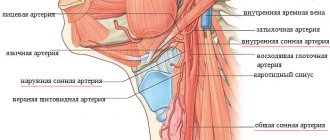One of the most important indicators of a child’s heart function, along with blood pressure, is heart rate. Heart rate shows how many times per minute the heart muscle contracts. The pulse in children is constantly measured, since it is used to determine how the baby is developing and what his general condition is.
Heart rate is a variable value that can change under the influence of many factors. The pulse can change due to physical activity, changing weather conditions, the baby’s mood and for other reasons. Such fluctuations in heart rate indicate the body’s adaptation to internal and external changes.
Another indicator that provides important information about the state of health and is always under the control of pediatricians is respiratory rate - respiratory rate. Using this indicator, doctors determine what kind of breathing the baby has (thoracic, abdominal), assess the functionality of the abdominal wall and chest, the rhythm and depth of breathing, and deviations from the norm.
These indicators depend on age and as the child grows, their values decrease.
What does tachycardia mean in a child?
Pediatric cardiologists consider it a disease when the number of heart beats per minute exceeds the norm by 20-30.
On a note! An impulse originates in the sinus node in the right atrium, which spreads to the atria and causes them to contract. The impulse is briefly delayed in the atrioventricular node between the ventricles and atria and transmitted to the ventricles, causing them to contract. The sinus node independently creates impulses within itself at a certain frequency. This is called "sinus rhythm."
Tachycardia is not an independent disease, but a sign of some other pathology. However, there is physiological tachycardia, which occurs during physical activity, emotional arousal, during eating, and when body temperature rises. This condition is completely harmless and does not threaten the child’s life. Tachycardia can occur even in a newborn child if he laughs, tries to make movements that are new to him, etc.
What is heart rate and why does it change with age?
Heart rhythm (heart rate) is an indicator of the number of heartbeats in one minute. The value is purely individual, it directly depends on gender, age, constitution, time of day, general psychological and physical state of a person.
In a newborn, the heart beats at its maximum frequency, but by the age of 13-15 it reaches the levels characteristic of an adult, reducing the rhythm by almost half. It depends on what:
- the myocardium loses its ability to stretch to its maximum;
- the blood volume changes in accordance with the enlargement of the heart chambers;
- the length of blood flow increases;
- the vessels gradually lose their elasticity;
- increased sensitivity to adrenaline.
Since heart rate is a marker of the work of the heart and blood vessels, it is very important to navigate its children’s age norms and, if necessary, control these numbers.
Types of heart rhythm disorders
Tachycardia is divided into three main types :
- Sinus is the most common. With it, the heart rate in the sinus node increases. Most often appears during physical activity. However, it may be the first sign of vegetative-vascular dystonia of the hypertensive type and other diseases of the cardiovascular system.
- Paroxysmal (ectopic) - a sharp increase in the number of heart contractions by two or three times. Manifested by shortness of breath, abdominal pain, cyanosis of the skin and mucous membranes. Source: E.L. Boqueria Ectopic atrial tachycardia in children: clinical picture, diagnosis and treatment // Annals of Arrhythmology, 2006, No. 3, pp. 16-19
- Chronic – a condition in which a child’s blood pressure decreases, convulsions, suffocation, and chest pain occur. Treatment is usually lifestyle changes. Parents should protect the child from psycho-emotional and physical stress, monitor his daily routine, ensure proper nutrition and general hardening of the body.
What is physiological maturity?
Physiological maturity implies the baby’s readiness for independent life outside the mother’s body. The concept extends to assessing the functioning of the main systems - nervous, cardiovascular, musculoskeletal, respiratory.
Even to a person far from science, it is obvious: in order for a baby to grow and develop harmoniously, his body must itself maintain a constant temperature, the lungs must exchange oxygen and carbon dioxide in the blood, and the heart must fully saturate all organs with blood.
Why is it so important to correctly assess physiological maturity? To preserve it in mature babies and help “mature” those who have deviations.
The more the baby corresponds to the concept of maturity, the less often he will get sick. Its correct development from the first days is insurance against endless viral infections, allergic reactions to drugs and diathesis.
Causes of the disease
Let us consider separately the causes of pathology in infants and preschoolers, schoolchildren, and adolescents.
Infants and preschoolers
In infants, severe tachycardia is considered to be a heart rate of more than 200 per minute. For preschoolers - depending on age, more than:
- six months – 185;
- 1 year – 160;
- 2 years – 150;
- 3 years – 140;
- 4 years – 135;
- 5 years – 120;
- 6 years – 115.
The reasons may be:
- fetal hypoxia during childbirth;
- anemia;
- dehydration of the body;
- fever;
- overheat;
- colds;
- congenital heart defects, which are diagnosed before birth and require constant monitoring. Source: A.I. Safina, I.Ya. Lutfullin, Z.A. Gainullina Heart rhythm disturbances in newborns // Practical Medicine, November 2010, No. 6(45), pp. 75-79
Often preschoolers do not want to do an ECG or even go to the doctor; they are capricious, worried, and cry. Under such conditions, an electrocardiogram will certainly show that the child has tachycardia. Therefore, it is better to conduct the study during sleep or after maximum calm.
Preschool children
Indicators of severe tachycardia are as follows (more than beats per minute):
- 7 years – 110;
- 8-10 years – 105;
- 11 years old – 104;
- 12 years old – 102.
The main reasons for an increase in heart rate at this age are emotional and physical stress. However, there are a number of diseases that cause such symptoms in this age group:
- myocarditis;
- primary rheumatic fever;
- long QT syndrome;
- Wolff-Parkinson-White syndrome.
In the last two syndromes, the tachycardia is not sinus. In Wolff-Parkinson-White syndrome, it is supraventricular, and the heart rate increases to more than 140 beats per minute. With an extended QT interval, paroxysms (increased) of ventricular tachycardia appear, fainting may occur, and the heart rate increases to more than 140 per minute. Source: https://www.ncbi.nlm.nih.gov/pmc/articles/PMC6595346/ Ranjit I. Kylat and Ricardo A. Samson Permanent junctional reciprocating tachycardia in infants and children // J Arrhythm. 2021 Jun; 35(3): 494–498
Teenagers
Severe tachycardia at this age is indicated when the pulse becomes more than (beats per minute):
- 13 years old – 100;
- 14-15 years old – 98.
The main reasons for an increase in heart rate in a teenager:
- rapid growth causing iron deficiency anemia;
- passion for diets;
- psychophysical fatigue;
- bad habits;
- poor physical fitness;
- excess production of thyroid hormones;
- high blood pressure;
- chronic pathologies of the heart and lungs.
Decoding the results
The normal pulse of a 17-year-old teenager can be found in the table. After the measurement, the value should be compared. If the indicator deviates slightly from the norm, it is impossible to say with a 100% guarantee that the child has some kind of disease.
Normal heart rate in teenagers, children and adults
This may be due to physiological reasons or incorrect measurement.
Symptoms of tachycardia in children
Symptoms and their intensity vary depending on the type of disease and its duration.
Main manifestations:
- vague discomfort in the heart area;
- feeling of heartbeat, heartbeat in the ears;
- lack of air, shortness of breath;
- pallor or blue discoloration of the skin and mucous membranes (in severe cases);
- weakness, fatigue, sluggish sucking in newborns;
- nausea due to dizziness;
- crying, anxiety;
- emotional arousal;
- faintness, loss of consciousness;
- sweating
Why is the physiological maturity of a newborn more important than a healthy weight or being born at term?
The most common criterion by which young mothers assess the condition of their baby is height and weight.
Born 3500 grams and 54 cm - a “hero”, and if 2800 grams - then sympathy and words of support immediately appear in the eyes of those around him: “It’s okay, he’ll gain more, but the birth went well.” But is it really important how much a baby weighs at birth? How will his height and weight affect his further development, resistance to diseases and psycho-emotional state?
Neonatologists and pediatricians, who have been observing the growth and development of children for years, have come to the conclusion that external signs in the form of weight and height do not provide much information about the child. Much more important is physiological maturity.
Diagnostic methods
- Electrocardiography (ECG). After examining the printout, the doctor will be able to determine the type of tachycardia and see, for example, heart failure.
- Daily Holter monitoring is intended to detect paroxysmal tachycardia. Electrodes are attached to the baby's skin and connected to a compact device that takes readings around the clock. Sometimes it takes more than a day.
- Ultrasound of the heart (Echo-CG) - allows you to see the structure of the heart, structural abnormalities, visualize large vessels and heart valves and chambers, the thickness of the walls of the organ, and evaluate its contractile function. Ultrasound allows you to see heart defects.
- A clinical blood test aimed at detecting anemia. With it, a compensatory acceleration of heart rate occurs.
- Biochemical blood test for glucose levels and electrolyte composition.
- Blood test for thyroid hormones.
- Electroencephalography (EEG).
- MRI of the heart - in rare cases.
- Electrophysiological study (EPS) of the heart is necessary to evaluate electrical activity and find the source of impulses in the paroxysmal type of tachycardia.
Musculoskeletal reflexes
These are motor reflexes that are characteristic of physiologically mature children. They represent the baby’s reaction to irritation of various parts of his skin.
- Robinson's reflex or "grasp" reflex
If you put an adult’s finger into the baby’s palm, he grabs it so tightly that the doctor can calmly lift the child on this finger. Because simultaneously with the contraction of the palm muscles, the overall tone of the body and all skeletal muscles are strengthened.
- Plantar reflex
The doctor touches the skin of the baby’s foot with line movements, that is, irritates it along the inner edge of the sole. In response to the impact, the baby extends the big toe and bends all the other toes. At the same time, it can be noted that the child bends his legs at the knee and hip joints, and the contractile activity of the remaining muscles of his body increases.
- Difficulty straightening the leg at the knee
If a child’s leg is bent at the hip joint, it is difficult to straighten at the knee joint. This is explained by the fact that in a physiologically mature infant, the tone of the flexor muscles always prevails over the tone of the extensor muscles.
- "Crawl"
If you put a child on his tummy and put your palm on his soles, he reflexively pushes away from it. A crawling effect is created, although the baby remains in place.
- Negative reaction to support
The baby, who is lifted vertically above the table, held under the arms, does not lean on it. Even if his legs are lowered to the table. The child bends his legs and pulls them towards his tummy.
- Heel reflex, or Arshavsky reflex
With moderate pressure on the baby's heel bone, a generalized reaction of the body occurs in the form of extensor motor activity, screaming and crying grimace.
- General motor activity of the baby
During sleep, physiologically mature infants exhibit spontaneous motor activity. It occurs due to periodic changes in the composition of the baby’s blood. Its manifestations are a separate trembling of the arms or trembling of the legs, more with a tendency to extension than to flexion.
Treatment of the disease
How to treat tachycardia will become clear after the cause is identified in the child. This pathology is treated by a cardiologist and other highly specialized specialists, depending on the results of the examination. For example, in case of problems with the thyroid gland, this will be an endocrinologist.
Important! If you find tachycardia in a child, then before consulting a doctor, exclude any stimulants from his diet - tea, coffee, chocolate, and protect him from stress as much as possible.
Therapy is selected individually, taking into account the underlying disease that caused the tachycardia. If a child has central nervous system dysfunction, a neurologist will prescribe sedatives. For heart pathologies, therapy is carried out by a cardiologist. At the same time, there are a lot of heart diseases, so treatment approaches vary. So, if an infection provokes myocarditis, then you will need to take an antibiotic. For autoimmune diseases that lead to arrhythmia, cytostatics and glucocorticosteroids are prescribed. Also, for any disease that causes tachycardia, the cardiologist can in any case prescribe a drug that will make the heart rate slower in order to relieve the load on the heart.
Respiratory system
Due to the immaturity of the nervous system, as well as the lipid metabolism system, the derivative of which is surfactant - a surface substance that ensures the opening of the lungs during the first breath and their normal functioning in the future, physiologically immature infants often develop a syndrome of respiratory disorders, which is manifested by the development of atelectasis. Atelectasis are areas of collapsed or incompletely straightened lung tissue that do not participate in breathing and can cause respiratory failure. Such a child is transferred to artificial ventilation until the respiratory system begins to function on its own. Against the background of respiratory distress syndrome, various infectious diseases (pneumonia) often occur, which certainly worsens the child’s condition.
What to do if a child has an attack of tachycardia before the doctors arrive?
Until the ambulance arrives, there are several ways to alleviate the child’s condition:
The most important thing is to calm the child down, open a window or vent so that fresh air can enter the room. The following measures can then be taken:
- Wipe the child's face with cold water, and then place a cloth soaked in cold water on his face.
- Have your child close his eyes and then gently apply pressure to his eyeballs for a few seconds. This will provoke a reflex in which the heart rate decreases.
- Perform a Valsalva maneuver - the child should close his mouth and nose tightly and strain as if he wants to exhale.
- Massage the carotid sinus, that is, the place where the carotid artery divides into two branches - external and internal. This place is located approximately where the thyroid cartilage is on both sides of the neck. It’s easy to feel the thyroid cartilage; in men it’s called the “Adam’s apple.” After this, move your fingers slightly downward, and immediately under the Adam’s apple you will feel the carotid sinus with a characteristic pulsation. Apply pressure and massage for a few minutes. Source: L.A. Balykova, I.S. Nazarova, A.N. Silence Treatment of cardiac arrhythmias in children // Practical Medicine, September 2011, No. (53), pp. 30-37
How and under what conditions does it appear?
A normal heart rate for a 15-year-old teenager can range from 61 to 81 beats/min. The indicator appears in the body due to the work of the heart. Its life activity is similar to a pump. That is, the heart pumps blood into the arteries.
Pulse waves are formed at the mouth of the aortic valve when fluid exits the left ventricle into the aorta and then spreads through the vessels at high speed. Stroke volume of blood occurs when systolic pressure increases, that is, the diameter of the arteries expands. And during diastole, the walls are restored to their original size.
The further the vessels are from the heart, the lower the pulse. For example, in capillaries it is impossible to feel the wave at the level of arterioles (small arteries).
Disease prevention
In order for not only the heart, but also the entire body to be strong and healthy, you must first normalize your diet. It is necessary to exclude all caffeine-containing drinks, as well as chocolate, fried foods and reduce the amount of sugar. The best diet is plant-based and dairy. Fruit juices and fresh vegetables are beneficial. Vitamin complexes will help reinforce the effect of the diet. The child must take magnesium and potassium, which normalize the heart rate. Consult your doctor first. And be sure to include moderate physical activity in your child’s daily routine, such as morning exercises. It stimulates the heart and increases its resistance to the release of excess adrenaline. As a result, irritability decreases and the emotional background normalizes. At the same time, you should not overexert yourself; any activity should be moderate. Swimming, for example, is very useful.
Sources:
- E.L. Boqueria. Ectopic atrial tachycardia in children: clinical picture, diagnosis and treatment // Annals of Arrhythmology, 2006, No. 3, pp. 16-19.
- A.I. Safina, I.Ya. Lutfullin, Z.A. Gainullina. Heart rhythm disturbances in newborns // Practical Medicine, November 2010, No. 6(45), pp. 75-79.
- https://www.ncbi.nlm.nih.gov/pmc/articles/PMC6595346/ Ranjit I. Kylat and Ricardo A. Samson. Permanent junctional reciprocating tachycardia in infants and children // J Arrhythm. 2021 Jun; 35(3): 494–498.
- L.A. Balykova, I.S. Nazarova, A.N. Silence. Treatment of cardiac arrhythmias in children // Practical Medicine, September 2011, No. (53), pp. 30-37.
The information in this article is provided for reference purposes and does not replace advice from a qualified professional. Don't self-medicate! At the first signs of illness, you should consult a doctor.
Nervous system
In physiologically immature children, the process of maturation of the nerve pathways - the formation of the myelin sheath around nerves and nerve fibers, or myelination - is not yet completed, therefore the conduction of nerve impulses to various organs and tissues is disrupted, which affects the viability of their functions. The peripheral nervous system is not sufficiently myelinated; bundles of nerve fibers are rare and unevenly distributed. Myelination normally continues in the postnatal period, i.e. after birth.
The walls of blood vessels in immature babies may consist of only one inner layer - the endothelium and do not contain smooth muscle tissue, collagen or elastin (especially if the mother has hypoxia during pregnancy and a deficiency of protein, iron, copper, vitamin C, etc.). That is, the formation of the connective tissue framework in the vascular wall does not end, which reduces resistance to hypoxia and increases the risk of developing intracranial hemorrhages.
In immature newborns, there is no mechanism for autoregulation of cerebral vessels due to the incomplete formation of vascular fibers. In addition, the metabolic activity of endothelial cells depends on the pathways that ensure the occurrence of oxidation processes, and therefore there is a high probability of their damage during hypoxia.
During childbirth, even without complications, the baby’s brain experiences significant stress. The pressure on the membranes of the brain becomes so strong that spasms, circulatory disorders, and hemorrhages in the brain can develop. These phenomena are more likely in premature and immature children due to immaturity of brain structures. To determine the degree of immaturity and damage to the central nervous system, the so-called neurological status of the newborn is described, which is determined by such factors as: behavioral state, muscle tone, motor activity, unconditioned reflexes, reaction to external stimuli.
Those with an immature nervous system have reduced motor activity and muscle tone, and are characterized by weakness and rapid decline of physiological reflexes. A slow reaction to stimulation is characterized by its prevalence throughout the entire body, weakness of active inhibition, and irradiation of the excitation process, i.e. irritation from one center spreads to another, but on a smaller scale. The immaturity of the cortex determines the predominance of subcortical activity: movements are chaotic, shudders, tremor (shaking) of the hands, clonus of the feet (convulsive muscle contractions in response to impact), twitching of the eyeballs, and transient strabismus may be observed.
Prices
| Name of service (price list incomplete) | Price |
| Appointment (examination, consultation) with a cardiologist, primary, therapeutic and diagnostic, outpatient | 1750 rub. |
| Prescription of treatment regimen (for up to 1 month) | 1800 rub. |
| Consultation (interpretation) with analyzes from third parties | 2250 rub. |
| Consultation with a candidate of medical sciences | 2500 rub. |
| Electrocardiography (ECG) | 1400 rub. |
| Echocardiography (ultrasound of the heart) | 3500 rub. |
Circulatory system
Due to the immaturity of bone marrow sprouts, as well as the low sensitivity of red bone marrow to erythropoietin (an active hormone of the kidneys that stimulates the production of red blood cells), lower levels of red blood cells and hemoglobin are observed in immature children, which leads to the development of early anemia of physiologically immature children, which develops during 2 first months of life. Rapid depletion of the white sprout leads to the development of neutropenia - a decrease in the number of neutrophils in the blood, especially in conditions of intra- and extrauterine infection of the child.
Physiologically immature newborns at birth have lower concentrations of vitamin K, vitamin K-dependent blood coagulation factors, and other disorders in the blood coagulation system. In this situation, bleeding from the first minutes of life can be combined with thrombosis due to the low activity of fibrinolysis and anticoagulants, which can lead to the development of DIC syndrome (disseminated intravascular coagulation syndrome).
Metabolic adaptation processes in immature infants are slowed down. They are more likely to experience hypoglycemia (low blood sugar), hypoxemia (low oxygen in the blood), hyperbilirubinemia (increased bilirubin in the blood serum), and early anemia in conditions of excess iron.
Digestive system
The digestive system of immature children also has a number of features. First of all, this is expressed in the immaturity of the enzyme system. The glands of the gastrointestinal tract do not produce the required amount of enzymes and gastric juice. When the gastrointestinal tract is colonized by microorganisms, even a small amount of pathogenic bacteria, which would normally be neutralized by the protective properties of gastric juice and pancreatic juice, causes dysbiosis in immature children (an incorrect ratio of certain microorganisms in the gastrointestinal tract).
Also, due to the immaturity of the nervous system and the transmission of nerve impulses, the motor function of the gastrointestinal tract suffers, and the movement of food through the gastrointestinal tract slows down. As a result, problems arise with the flow of food into different parts of the stomach and intestines and its excretion.
Features of the gastric tract in physiologically immature infants are:
- poor development of the sphincter at the entrance to the stomach, which leads to frequent regurgitation;
- poor development of longitudinal muscle bundles of the stomach wall, which causes lethargy and bloating due to overfeeding and exposure to air
- slow evacuation of stomach contents (130-140 min);
- high viscosity of original feces.
Despite the imperfection of the digestive system in physiologically immature infants, the gastric juice still contains rennet, which curdles milk. Therefore, mother's milk is mandatory for an immature child. In addition to its nutritional value, milk provides an invaluable service to protect the baby’s body from environmental aggression. Therefore, even if the child is immediately after birth in the intensive care unit or intensive care unit and receives parenteral nutrition (via a drip) or is so weak that he cannot breastfeed, it is necessary to take all possible measures to preserve breast milk, feed the baby from a spoon . This is one of the necessary factors when nursing immature babies.
In physiologically immature newborns, functional inferiority of the liver is possible; as a result, an insufficient amount of the enzyme glucurone transferase is produced, and this predisposes to the development of prolonged jaundice. A low level of prothrombin causes increased bleeding.
Immature children are predisposed to intestinal dysfunction. The intestinal wall has increased permeability, so microbes and toxins in the intestines are absorbed through the intestinal wall into the blood. Due to hypotension of the intestines and the anterior abdominal wall, flatulence is often observed; as a result, the diaphragm rises upward, squeezing the lower parts of the lungs and disrupting their normal ventilation.
The mucous membrane of the digestive canal in immature children is tender, thin, and easily vulnerable. There is low proteolytic activity of gastric juice, insufficient production of pancreatic and intestinal enzymes, as well as bile acids. All this complicates the processes of digestion and absorption, contributes to the development of flatulence and dysbacteriosis. Many immature children, even those who are breastfed, have a deficiency of intestinal bifid flora in combination with the carriage of opportunistic flora.
The nature of a child's stool is determined by feeding characteristics; As a rule, in the coprogram of physiologically immature children there is a lot of neutral fat.
Functional disorders of the gastrointestinal tract are one of the most widespread problems among children in the first months of life. A distinctive feature of these conditions is the appearance of clinical symptoms in the absence of any organic changes in the gastrointestinal tract (structural abnormalities, inflammatory changes, infections or tumors) and genetic metabolic abnormalities.
With functional disorders of the gastrointestinal tract, motor function, digestion and absorption of nutrients, as well as the composition of the intestinal microbiota and the activity of the immune system may change. The causes of functional disorders often lie outside the affected organ and are caused by a violation of the nervous and humoral regulation of the digestive tract.
Genitourinary system
Water-mineral metabolism in physiologically immature newborns is labile, so children are equally predisposed to the formation of edema and the development of dehydration (dehydration).
Early edema develops in utero or in the first hours and days after birth. In the pathogenesis of edema, in addition to renal factors, hypoproteinemia plays a significant role, which is important in maintaining plasma oncotic pressure. Clinically, early edema is expressed in mild tissue infiltration (from general pastiness to massive generalized edema that does not have a specific localization). They disappear 1-2 weeks after birth.
Late edema appears 2-3 weeks after birth and is characterized by a specific localization: on the thighs, legs, feet, pubis, lower third of the abdomen. They are dense to the touch, with smooth, shiny, low-elastic skin. The appearance of edema is associated with the nature of feeding, with illnesses of the child or with severe hypoproteinemia (low levels of proteins in the blood).
Skeletal system
In physiologically immature children, the skeletal system is formed by birth, but bone mineralization is often not yet complete, and therefore they additionally need calcium (as recommended by a doctor).
And in prematurely born immature children there is often a deficiency of vitamin D, since it is in the last months of pregnancy that a supply of substances such as vitamin D, calcium, and phosphates occurs. If mom gets all this in abundance. A reduced amount of these substances in the body causes the development of diseases such as rickets, the signs of which are softening of the bones, slowing down of growth processes, especially of the legs, late appearance of teeth and closure of the large fontanelle, changes in the pelvic bones, as well as hip dysplasia, when due to lack of calcium, the femurs become deformed. Physiologically immature children are at risk for developing this disease. In them it is especially acute and progresses quickly. Therefore, physiologically immature children are often prescribed vitamin D to prevent rickets.
It happens that physiologically immature children are born with unformed hip joints. Dysplasia (underdevelopment) of joints threatens further subluxations, dislocations and deprivation of the ability to move independently. Therefore, it is necessary to diagnose this pathology in time and prescribe treatment. To detect dysplasia, an ultrasound examination of the joints is performed, which allows for a correct diagnosis. A common cause of joint dysplasia is a mother’s deficiency of magnesium, iron, protein, vitamin C and other nutritional factors during pregnancy.
The basis of the physiological maturity of the baby is the correct course of pregnancy
For the harmonious development of the baby and the timely maturation of all its systems, maximum attention should be paid to the stages of preparation for pregnancy and the first weeks of pregnancy. This is the time when fetal exposure to drugs, alcohol, nicotine and other substances is especially dangerous. This is the time when any nervous stress of the mother is reflected in the processes occurring with the baby. Hunger in the mother, even hidden hunger in the form of a deep deficiency of the most important nutritional factors (amino acids, B vitamins, iron, oxygen, iodine, omega-3 polyunsaturated fatty acids, etc.) can also be the cause of the physiological immaturity of the baby.
Tune in to a positive pregnancy. Make sure that there is no teratogenic effect in every tablet you are going to swallow, in every food you eat or glass of liquid you drink, in every cream, toothpaste, procedure, and detergent.
Pregnancy lasts only nine months. Therefore, a “sacrifice” in the form of refusing a glass of wine, a cosmetic procedure or a long flight is nothing compared to a healthy baby, ready for life in a new world.
Maximum adherence to regimens that meet the needs and rhythms of the newborn!
Early and regular latching of the baby to the breast should not be ignored, even if after this latching the baby is bottle-fed. The connection between mother and baby helps him better adapt to the conditions of the “new” environment. The later breastfeeding is started, the worse it is for the baby. Delaying feedings for 2-4 days from the moment the baby is born can have a negative impact: a baby recognized as physiologically mature at birth will show signs of physiological immaturity.
For mothers whose child was born physiologically mature, it is very important to have adequate nutrition for absolutely all ingredients: protein, carbohydrates, saturated and polyunsaturated fats, vitamins, microelements. It is necessary to enrich your diet with vitamin-mineral complexes, well-digestible proteins (meat, fish, cottage cheese, eggs), offal, vegetables, fruits, berries, and a moderate amount of boiled cereals (rice, buckwheat).
You should not eat more often than 4 times a day and drink tea with milk 20 minutes before or after feeding. It is enough to drink a few sips of water before feeding the baby, and quench your thirst if necessary, but not with sugary drinks. Carbonated drinks, especially cola-type drinks, are prohibited.
It is important that the baby stays with the mother frequently, caresses, plays with the baby, and kind words from the first days of birth. But the baby should sleep in his crib or in a stroller in the fresh air (as often as possible).
It is necessary to put the baby to the breast regularly, even in the absence of breastfeeding. In this case, the baby must hold the nipple in his mouth for at least ten minutes, after which he can be offered a bottle.
The air temperature in the room should be from 18 to 20 degrees during wakefulness (this temperature stimulates physical activity), from 20 to 22 degrees during sleep. At an ambient temperature of about 32 degrees Celsius, the baby’s physical activity is practically zero, which is harmful, not a concern.
Often immature babies are prescribed therapeutic massage. But only a specialist should do it. Mothers must master the rules of stroking and light massage for newborns.










